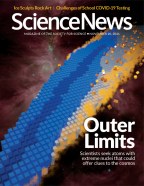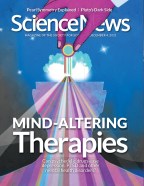Readers react to extreme nuclei, recycled batteries and more
- More than 2 years ago
Nuclear wonders
A new particle accelerator at the Facility for Rare Isotope Beams will help scientists unlock the inner workings of atomic nuclei and explore how elements form in the cosmos, Emily Conover reported in “In search of extreme nuclei” (SN: 11/20/21, p. 20).
Conover reported that a rare variety of lithium, called lithium-11, has two extra neutrons that form a wide halo around the nucleus, expanding the nucleus’ size.
Reader Bob Conover, no relation to Emily Conover, asked how lithium-11’s halo neutrons can expand the nucleus.
In quantum physics, a neutron isn’t localized to one spot within a nucleus, Emily Conover says. Instead, it is described by a wave function, which gives the probability of finding a neutron in a given place. Each halo neutron in lithium-11 has a wave function that is spread out much more than a normal neutron in a nucleus, she says. That makes the nucleus large, in the sense that it can collide with another nucleus even when the two nuclei are separated by a relatively large distance. While the halo neutrons are weakly bound to the nucleus, they are indeed bound.
Tick tock
An atomic clock detected how general relativity warps time across a millimeter, revealing the extreme precision achievable by such clocks, Emily Conover reported in “Gravity warps time on tiny scale” (SN: 11/20/21, p. 10).
Reader Richard Boyer wondered if the accuracy of a wristwatch changes as a person swings the watch-wearing arm.
“As you swing your arm, your watch could tick very, very slightly faster or slower,” Conover says. “That’s because each point in Earth’s gravitational field will have a specific rate of time determined by the gravitational potential at that point.” But the slight changes aren’t enough to throw off your daily schedule.
Oldie but a goodie
Lithium-ion batteries with recycled cathodes can last longer than batteries with new cathodes, Carolyn Wilke reported in “Recycled materials can make long-lasting batteries” (SN: 12/4/21, p. 4).
Reader Ann Hoffenberg wanted to know how the recycled batteries outperformed the new ones.
The researchers don’t know exactly why the recycled batteries’ cathodes perform better, but they think it’s because the recycling process used in the study made the material’s microstructure more porous, Wilke says. When a battery is discharged and recharged, it goes through stages of shrinking and expanding. The more porous material seems to endure that process better, which is important for battery performance, she says.
Signal senders
Cells called neuroids crawl around sponges’ digestive chambers and send messages, a communication system that offers hints about how nervous systems evolved, Laura Sanders reported in “Brainless sponges may have echoes of a nervous system” (SN: 12/4/21, p. 32).
Sanders reported that in the studied sponges, some hairlike cilia — which help keep the animals fed by moving nutrients through feeding chambers — near neuroids were bent at angles that suggested the cilia were no longer moving. Reader James Wilcox wondered why the cilia get bent.
The researchers suspect that the bent shape indicates a sort of freeze, Sanders says. Neuroids might send small packages of chemical signals that stop the cilia’s normal movement, putting the brakes on the sponge’s meal.

